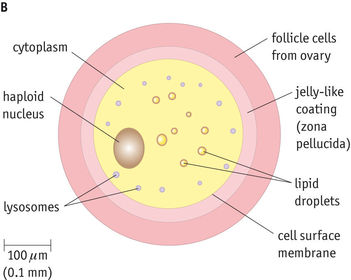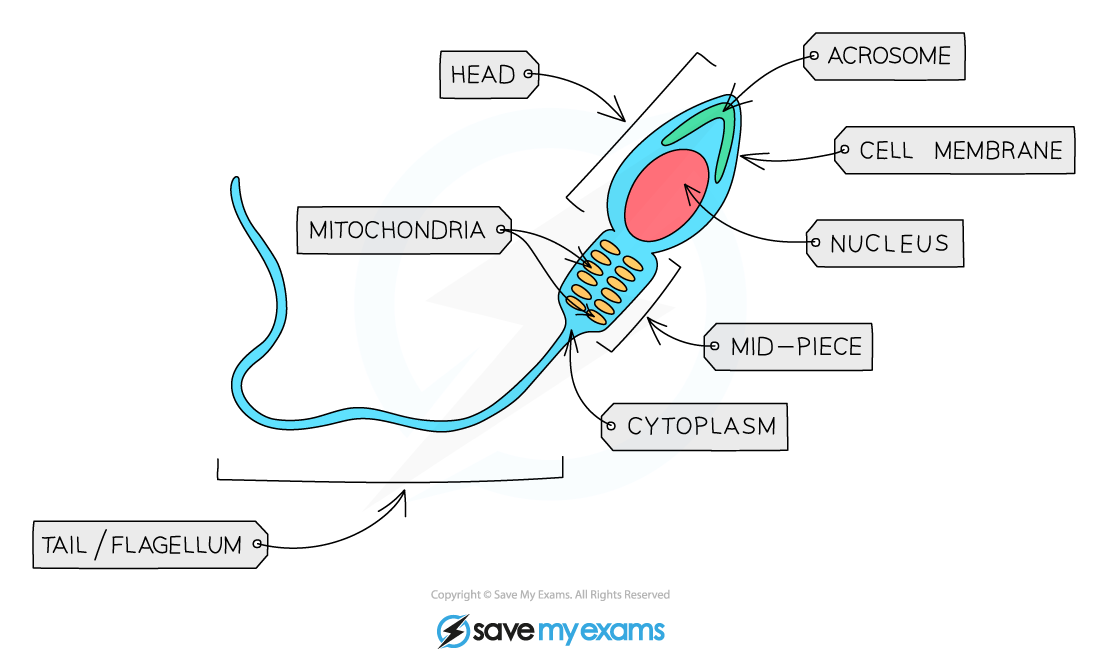Topic 3- voice of the genome
1/60
Earn XP
Name | Mastery | Learn | Test | Matching | Spaced |
|---|
No study sessions yet.
61 Terms
cell
basic unit from which living organisms are built. can be specialised for a particular function
tissue
a group of one type of specialised cell which work together to carry out a specific function
organ
a group of different tissues which work together to carry out one or more functions
organ system
a group of different organs working together for the same function

ovum structure
large gamete- many sperm able to fit for increased chances of fertilisation, contains lipid droplets for energy during fertilisation
zona pellucida- hardens when one sperm has entered to prevent polyspermy
cortical granules (lysosomes)- release enzymes that cause the zona pellucida to harden
cytoplasm with protein and lipid droplets- food source to supply energy for cell division of the fertilised ovum
haploid nucleus- contains half the number of chromosomes so the diploid chromosome number is restored at fertilisation. mixing of alleles allows for genetic variation

sperm cell structure
flagellum allows sperm to swim to reach the ovum
many mitochondria allow it to carry out aerobic respiration and release energy as ATP so the tail can move
acrosome- specialised lysosome that contains and releases digestive enzymes that hydrolise the zona pellucida to enable to sperm’ entry into the ovum
haploid nucleus
the acrosome reaction
digestion of the zona pelluucida to allow the sperm to enter the ovum
the cortical reaction
hardenig of the zona pellucida to prevent polyspermy
fusion of the nuclei
when the sperm nucleus fuses with the ovum nucleus fertilisation is complete
human chromosomes
46 in total, so 23 pairs
haploid
half the number of chromosomes of a somatic cell
diploid
full number of chromosomes found in a somatic cell, with two copies of each chromosome
importance if mieosis
creates haploid cells, to maintain the diploid number after fertilisation
ceates genetic variation in gametes and therefore offspring
independent assortment
random aligning of maternal and paternal chromosomes along the equator of the cell to produce new combinations of chromosomes/ alleles
crossing over
breaking and rejoining of non-sister chromatids on the same chromosome pair causes exchange of alleles, followed by recombination of alleles between chromatids
stem cell
an undifferentiated (unspecialised) cell that can give rise to other specialised cell types- there is no limit to division. can by totipotent, pluripotent, or multipotent
totipotency
when an undifferentiated stem cell can give rise to all specialised cell types (216 in the human body). there is no limit to division, and all genes are switched on
pluripotency
when an undifferentiated stem cell can give rise to some specialised cell types except totipotent embryonic stem cells. no limit to division, some genes switched off
multipotency
An undifferentiated cell which can give rise to only specialised cell types of a closely related family. many genes are switched off.
embryonic stem cells
can be a zygote (fertilised egg) or 8 cell embryo- totipotent
can be the inner cell mass of a blastocyst- pluripotent
disadvantage: ethical issues as they are obtained from spare embryos in IVF and risk of rejections, infection, or cancer when used in treatments
umbilical cord stem cells
from the umbilical cord blood or placenta- pluripotent
adult stem cells
from the bone marrow or brain/connective/skin/liver cells- multipotent
disadvantage: are multipotent, limitations to tissues able to be given ise to, few present in the body, difficult to extract
plant stem cells
plant cells remain totipotent throughout life so a complete plant can be grown from a fragment/explant by plant tissue culture
plant tissue culture
an explant of a plant tissue is placed on a sterile agar containing nutrient and growth regulators- done by aseptic technique. the explants are placed under a light bank for 4 weeks and the cells will differentiate to create a genetically identical clone of the original plant
uses of plant tissue culture
improve plant and food crop species
produce increased quantities of plant chemicals used in drug production
produce commercial plants that are difficult to grow from seed
conserve endangered plant species
medical uses of stem cells
give rise to specialised cells in the body to replace dead or damaged tissue
producing tissues or organs for transplant
to treat diseases caused by damaged cells
therepeutic cloning
the nucleus of an egg cell is removed. a diploid somatic cell is removed from the patient and the nucleus from the patient’s cell is placed inside the egg cell. the new cell is stimulated electrically to divide by mitosis to form a blastocyst. pluripotent stem cells are removed and encouraged to develop into tissues/organs identical to those of the patient. tissue is not rejected as cells are genetically identical to the patient’s own.
induced pluripotent stem (iPS) cells
adult/multipotent cells whic have been genetically reprogrammed to become like embryonic stem cells, by being forced to express genes and factors important for maintaining the defining properties of embryonic stem cells
roles of the human fertilisation and embryology authority (HFEA)
decide on maximum age of embryo allowed to be used for research
to consider ethical issues
to check acceptability of the source of stem cells
stop human cloning
stop unnecessary repeating of research
arguments for the use of embryonic stem cells
offers treatment to patient of diseases
multipotent stem cell research is slower in progression
could still happen in other countries if banned in the UK
spare IVF embryos would be destroyed anyways
research with embryonic stem cells is needed to develop use of adult ones
embryo is not considered new human unless viable
arguments against embryonic stem cell research
embryos are considered unborn children
much embyonic stem cell treatment may be fraudulent, badly regulated, and exploitative of suffering
waiting a few years might lead to the same benefits through multipotent stem cells
diverts funding away from alternatives
an embryo becomes a new human at moment of conception
mitosis
nuclear division of the nucleus where two genetically identical daughter diploid nuclei are produced from one parent diploid nucleus. it is a stage in the cell cycle
role of mitosis
to produce 2 new genetically identical cells to the parent cell, each with the diploid number of chromosomes
to increase cell numbers for growth
to replace damaged or dead cells to repair damaged tissue
asexual reproduction
cell cycle First stage- INTERPHASE
G1 phase- cell growth, organelle and enzyme production
S phase- semi-conservative replication of DNA and doubling of cell contents
G2 phase- cell growth for proteins involved in mitosis
cell cycle Second stage- MITOSIS
prophase- condensing of chromosomes, centrioles move to opposite poles and form the spindle. nuclear envelope breaks down
metaphase- chromosomes attatch to spindle fibres by their centromeres and line up along the equator
anaphase- centromeres split and chromatids are seperated. spindle fibres pull both sets of chromatids to the opposite poles
telophase- chromosomes decondense and nuclear envelope reforms around both groups, spindle breaks down
cell cycle Third stage- CYTOKINESIS
ring of protein filaments on the inside of the cell surface membrane contract and constrict to divide the cell. plant cells synthesise a new cell plate down the middle of the cell
the lac operon
an example of gene expression in the E.coli bacterium. the chemical stimulus for switching on the β-galactosidase gene is lactose
switching on and eukaryotic expression of a gene
DNA is uncoiled and a regulator protein (transcription factor) and RNA polymerase bind to the promoter region, switchig the gene on. it can now be expressed by transcription and translation
switching off of a gene
protein repressor molecule binding to the promoter region causes the attatchment site to be blocked. repressor molecule could also bind to regulator protein
differential gene expression
correct chemical stimulus is required, some genes are switched on or off. mRNA only transcribes switched on genes so that different proteins are made in different cells.
proteins produced permenantly modify a cell to specialise it
formation of tissues from cells
similar specialised cells recognise each other using adhesion/recognition molecules- glycoproteins on the cell membrane, which have complementary shapes and can bind to each other through the tissue fluid surrounding cells to form a tissue
role of gene expression in development
the epigenome helps to control the change from a zygote to an adult. during development epigenetic changes will bring about specialisation of the cell, where signals can result in changes to the epigenome that alters the genes transcribed
master genes
control the development of segments of an organism. the master gene produces mRNA that is translated into signal proteins which switch on the genes responsible for producing the proteins needed for specialisation of cells in each segment
apoptosis
programmed cell death- cells die during normal development of an organism
variation
the differences that exist between individuals
continuous variation
a range of phenotypes and genes at different loci and also environment, for example height and weight
discontinuous variation
phenotypes fall into discrete groups, with genes at one single locus- not affected by environment. eg, blood groups and sex
polygenic inheritance
when more than one gene codes for a single characteristic, with each gene at a different locus. genes interact with each other and have additive effects. it contributes to continuous variation
polygenic inheritence and the environment
many genes involved each with a small effect. they interact and the additive effect of the alleles produce many different genotypes and effects of the environment may cause more variation
diseases where alleles may confer a suseptability but environmental factors also contribute
diabetes, coronary heart disease, alzheimer’s, schizophrenia, and some cancers
locus
the position of a gene/allele on a chromosome
gene linkage
linked genes are found on the same chromose at different loci. they have a high chance of being inherited together, because when chromatids seperate in mieosis II all the genes on the chromatid move as one unit and enter the same gamete. the greater distance between the loci, the greater the likehood of crossing over happening and seperating them
sex-linked genes
an allele or gene responsible for a trait is located on a sex chromosome, and expression of this trait is related to gender
autosomal chromosomes
chromosomes that are not sex chromosomes. humans have 22 pairs of them
examples of sex-linked conditions
colour blindness
haemophilia
eye coour in drosophila
human skin colour- environmental factor UV light
high UV light causes more MSH to be produced by the brain and more MSH receptors to form on melanocytes
more MSH binds to the receptors causing gene activation and more melanin made
melanocytes make more melanosomes, which are transferred to skin cells where they gather around the nucleus to screen it from UV light protecting DNA from sun damage- skin darkens
human hair colour
exposure to UV causes chemical and physical changes to melanin causing hair to lighten
cancer definition
disease resulting from uncontrolled cell division which forms a malignant tumour (mass of abnormal, unspecialised cells) which invades and destroyes surrounding tissue
how does cancer arise
environmental mutagens increase the risk eg UV
mutations occur in DNA of tumour repressor genes or protooncgenes (genes that code for proteins that regulate the cell cycle)
cell cycle is disrupted as there are no stops on it, leading to uncontrolled cell division
lack of apoptosis, so rate of cell multiplication by mitosis is greater than the rate of cell death
abnormal mass of unspecialised cells forms
cells do not become specialised and growth cannot be controlled
some cancer cells break off and travel to other parts of the body and cause secondary tumours
risk factors of cancer
carcinogens in cigarette smoke- cause mutations in DNA in lung cells
UV radiation- causes mutations in DNA skin cells, tumours can develop from an established mole
free radicals from smoke UV and cell metabolism may cause mutations, lack of antioxidants to neutralise free radicals increases risk
viral infection- virus’s DNA may contain an oncogene which affects the cell cycle